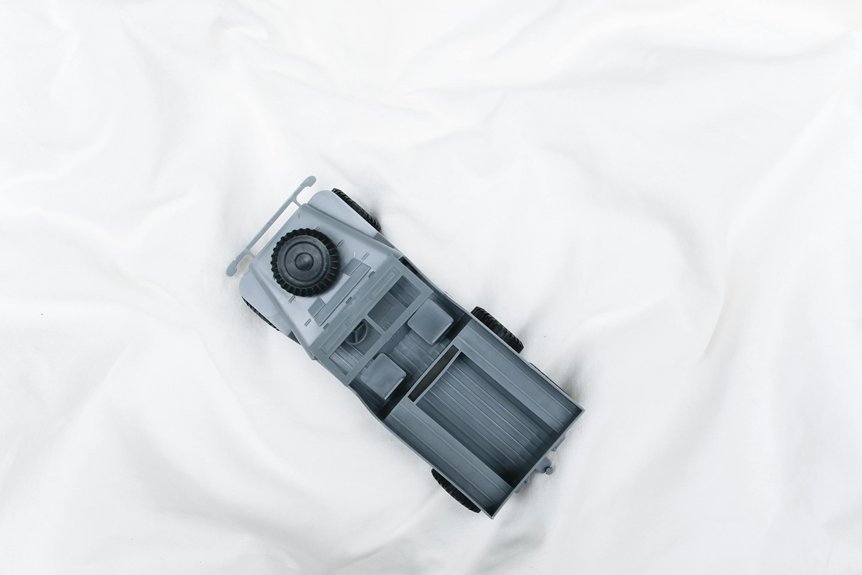Painting plastic car parts like a pro starts with the right materials and technique. First, gather automotive-grade paint, high build plastic primer, and various sandpaper grits. Remove the parts carefully and clean them thoroughly with warm soapy water. After drying, mask off areas to avoid overspray. In a well-ventilated space, hold the spray paint 6-8 inches away and use a crisscross technique for even coverage. After each coat, wait 15-30 minutes before adding another. Finally, let the paint cure fully and apply a clear coat for protection. Stick around to uncover additional expert tips and techniques!
Key Takeaways
- Prepare the plastic parts by cleaning and sanding them thoroughly to ensure proper paint adhesion.
- Use high build plastic primer and automotive-grade paint designed specifically for plastics.
- Apply spray paint in light, even coats using a crisscross technique, allowing 15-30 minutes between coats.
- Allow the painted parts to cure in a dust-free environment for at least one week before handling.
- Regularly maintain painted surfaces with mild soap, reapplying a clear coat for added protection against UV damage.
Suitable Plastic Parts for Painting
When it comes to enhancing your vehicle's appearance, the right choice of plastic parts can make all the difference. Automotive plastic parts, like door handles, mirrors, bumpers, wheel covers, and spoilers, are ideal candidates for painting. By applying paint to these components, you can create a refreshed look that matches your car's color scheme or reflects your personal style.
Door handles are particularly effective for this type of customization, as they often stand out and can easily be matched to the vehicle's overall aesthetic. Mirrors also offer a great opportunity for painting, allowing you to enhance the design without significant investment.
Bumpers can benefit from a coat of paint, improving their appearance while protecting them from environmental damage. For a successful painting project, ensure you use a good primer for better adhesion and coverage. This step is crucial in achieving a smooth finish that lasts.
Don't forget to consider wheel covers and spoilers, as they provide unique customization options that can truly enhance your vehicle's identity. With the right approach, painting these plastic parts can transform your car into a head-turning masterpiece. Additionally, understanding plastic furniture benefits, such as durability and low maintenance, can help you make informed decisions when selecting materials for your automotive projects.
Tools and Materials Required
To achieve a professional finish on your plastic car parts, you'll need the right tools and materials at your fingertips. Start by selecting automotive-grade paints specifically designed for plastics, like Rust-Oleum®, which ensures excellent adhesion and durability.
For surface preparation, gather a variety of sandpaper grits ranging from 150 to 1200 to sand the surface effectively, creating a smooth finish that enhances paint adhesion.
Next, you'll require a high build plastic primer, which helps improve the adherence of the paint and creates an even base layer. Once you've primed, you're ready to apply the paint; use even strokes for the best results.
Don't forget to consider clear coat options, as these can provide added protection and increase the durability and resistance of your finish.
Lastly, don't overlook your protective gear. Equip yourself with a mask to avoid inhaling harmful chemicals and gloves to protect your skin from paint and solvents.
With these tools and materials, you're well on your way to successfully paint plastic car parts like a pro! Additionally, choosing the right type of plastic paint, such as low VOC options, can contribute to a safer and more environmentally friendly painting process.
Preparation and Cleaning Steps
Now that you've gathered all the necessary tools and materials, it's time to focus on preparation and cleaning steps for the plastic car parts. First, use a screwdriver to remove the plastic parts from your vehicle, keeping the screws organized to avoid mixing them up during reinstallation.
Next, clean the plastic pieces thoroughly with a mixture of warm soapy water. Scrub them with a scouring pad to create surface abrasions, which will ensure better paint adhesion.
Once the surfaces are clean, dry the plastic parts completely with a lint-free towel to prevent any moisture from interfering with the painting process.
To prepare your workspace, lay down drop cloths in a well-ventilated area to protect the ground from paint overspray. Secure the drop cloths with heavy objects on the corners to keep them in place.
Finally, use masking tape to cover areas you don't want to paint. This will help you remove any bobbles and achieve clean lines, preventing paint from getting on undesired surfaces.
With these preparation and cleaning steps completed, you're ready to move on to the next phase of your project! It is also crucial to consider the plastic yellowing process that can occur over time and take preventative measures to maintain the appearance of your car parts.
Painting Application Techniques
With the preparation steps complete, you're ready to dive into the painting application techniques that will give your plastic car parts a professional-looking finish. Start by choosing a well-ventilated area for your work to reduce inhalation of fumes. When using spray paint, maintain a consistent distance of 6-8 inches from the surface. This will help you apply multiple thin and even coats without drips or runs.
Follow a crisscross spraying technique to cover the entire surface area uniformly, ensuring a smooth finish. Allow 15-30 minutes between coats for proper adhesion and finish quality. Before you begin painting the actual parts, don't forget to test spray on a cardboard or scrap piece to confirm your desired color and consistency. It's also essential to consider the surface energy of the plastic material to ensure effective paint adhesion and a lasting finish.
Here's a quick reference table to guide you through the process:
| Step | Action | Time |
|---|---|---|
| 1 | Prepare the area | – |
| 2 | Apply primer | 15-30 minutes |
| 3 | Apply first coat of paint | 15-30 minutes |
| 4 | Apply second coat of paint | 15-30 minutes |
| 5 | Apply clear coat | 15-30 minutes |
This method will help you achieve a glossy finish and good results!
Final Touches and Maintenance
Achieving a flawless finish on your painted plastic car parts doesn't end with application; final touches and maintenance play a crucial role in preserving that look.
After painting, let the paint cure in a dust-free environment for at least a week to ensure full adhesion and durability. Once the paint's dried, inspect painted surfaces for imperfections. If you spot any, perform light wet sanding with 2500 grit sandpaper to smooth them out before applying a final clear coat.
To maintain appearance, regularly clean the surfaces with a mild soap and water solution, avoiding abrasive cleaners that can scratch the finish. Periodically reapply a clear coat or protective layer. This shields your paint from environmental damage, especially on exterior parts exposed to UV light.
When storing painted parts, use bubble wrap or other protective materials to prevent chips and scratches during transportation. Additionally, following a regular maintenance routine, such as the one outlined for plastic furniture, can help extend the lifespan of your painted car parts, with techniques like UV protection being essential for exterior components.
Frequently Asked Questions
How Do You Paint Plastic Car Parts?
To paint plastic car parts, clean them thoroughly, sand the surface lightly, and apply primer followed by color paint. Finish with clear coat for protection. Allow adequate drying time between each layer for best results.
What Is the Best Paint for Plastic Car Parts?
When choosing paint for plastic car parts, consider acrylic enamel for durability, acrylic lacquer for gloss, or polyurethane for exterior protection. Rust-Oleum® offers strong adhesion, while water-based paints are eco-friendly and quick-drying for interior surfaces.
How Many Coats of Primer on Plastic?
You should apply 3-4 coats of primer on plastic parts for optimal adhesion. Allow each coat to dry for about 15 minutes, and lightly sand between layers to ensure a smooth finish before painting.
How to Paint Plastic so It Doesn't Chip?
To paint plastic so it doesn't chip, clean and sand the surface thoroughly. Use a high-quality primer and flexible, UV-resistant paint. Apply multiple thin coats, finishing with a clear coat for added protection.

